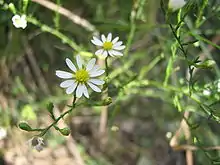Symphyotrichum depauperatum
Symphyotrichum depauperatum, also known as the serpentine aster,[4] is a rare species of aster adapted to serpentine barrens, an ecosystem with a high concentration of toxic metals in the soil.[5]
| Symphyotrichum depauperatum | |
|---|---|
 | |
| S. depauperatum from the serpentine grassland demonstration area in Nottingham County Park. | |
| Scientific classification | |
| Kingdom: | Plantae |
| Clade: | Tracheophytes |
| Clade: | Angiosperms |
| Clade: | Eudicots |
| Clade: | Asterids |
| Order: | Asterales |
| Family: | Asteraceae |
| Genus: | Symphyotrichum |
| Species: | S. depauperatum |
| Binomial name | |
| Symphyotrichum depauperatum | |
| Synonyms[2][3] | |
| |
Symphyotrichum depauperatum is a perennial herb up to 50 cm (20 inches) tall, with 1-3 stems. Leaves are narrow, generally 2–4 cm (0.8-1.6 inches) long. The plant produces numerous flower heads in branched arrays, each head with 7–14 white or pink ray flowers surrounding 7–17 yellow disc flowers.[5]
Distribution
Symphyotrichum depauperatum grows in 20 of the 26 serpentine barrens in the east-central United States (Pennsylvania, Maryland, Virginia, North Carolina),[6] and has been called a "flagship" species of this unique ecosystem. It was previously thought to be endemic to these barrens, but it was recently confirmed to also occur in a disjoint population on diabase glades in North Carolina.[7]
Conservation
Symphyotrichum depauperatum is classified by the state of Pennsylvania as a threatened species because its range is restricted to a few limited areas, and the majority of its populations occur on sites threatened by quarrying, housing and industrial development.[8]
References
- "Symphyotrichum depauperatum", NatureServe Explorer, NatureServe, retrieved 2009-11-12
- "Symphyotrichum depauperatum (Fernald) G.L.Nesom", The Global Compositae Checklist (GCC) – via The Plant List
- "Aster depauperatus Fernald", Tropicos, Missouri Botanical Garden
- "Symphyotrichum depauperatum", Natural Resources Conservation Service PLANTS Database. USDA, retrieved 6 December 2015
- Brouillet, Luc; Semple, John C.; Allen, Geraldine A.; Chambers, Kenton L.; Sundberg, Scott D. (2006), "Symphyotrichum depauperatum", in Flora of North America Editorial Committee (ed.), Flora of North America North of Mexico (FNA), 20, New York and Oxford – via eFloras.org, Missouri Botanical Garden, St. Louis, MO & Harvard University Herbaria, Cambridge, MA
- "Symphyotrichum depauperatum", County-level distribution map from the North American Plant Atlas (NAPA), Biota of North America Program (BONAP), 2014
- Gustafson, Danny J.; Latham, Roger Earl (Jun 2005), "Is the serpentine aster, Symphyotrichum depauperatum (Fern.) Nesom, a valid species and actually endemic to eastern serpentine barrens?", Biodiversity and Conservation, 14 (6)
- "Serpentine Aster profile", Pennsylvania Department of Conservation, Natural Resources Wildlife Resource Conservation Fund, archived from the original on 2011-06-10, retrieved Sep 19, 2009
External links
 Media related to Symphyotrichum depauperatum at Wikimedia Commons
Media related to Symphyotrichum depauperatum at Wikimedia Commons Data related to Symphyotrichum depauperatum at Wikispecies
Data related to Symphyotrichum depauperatum at Wikispecies
